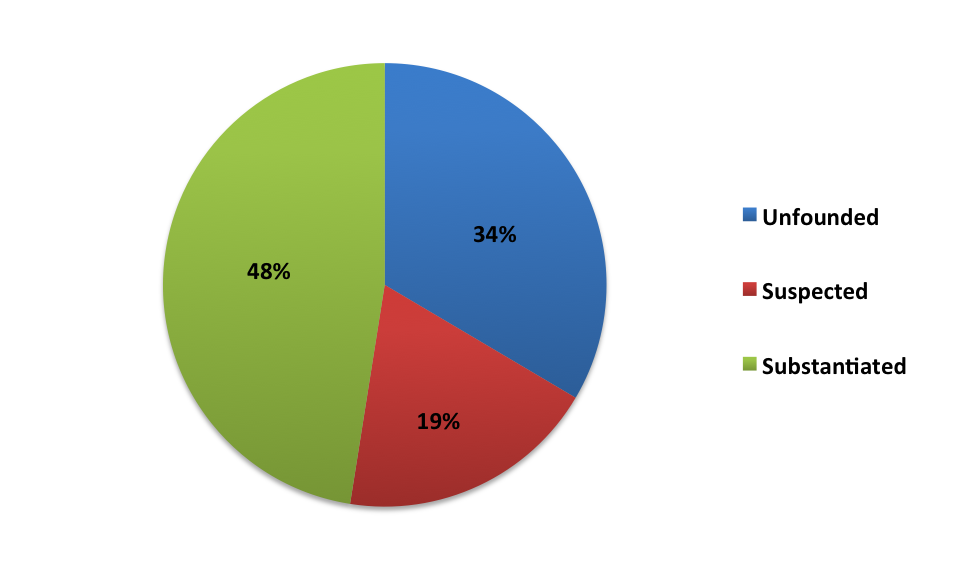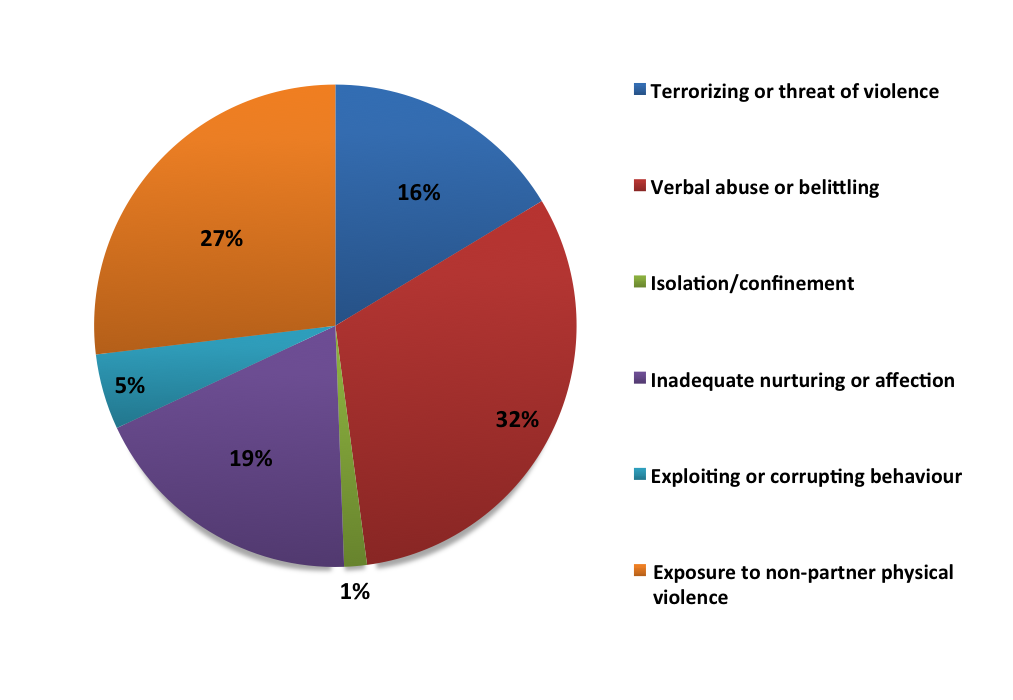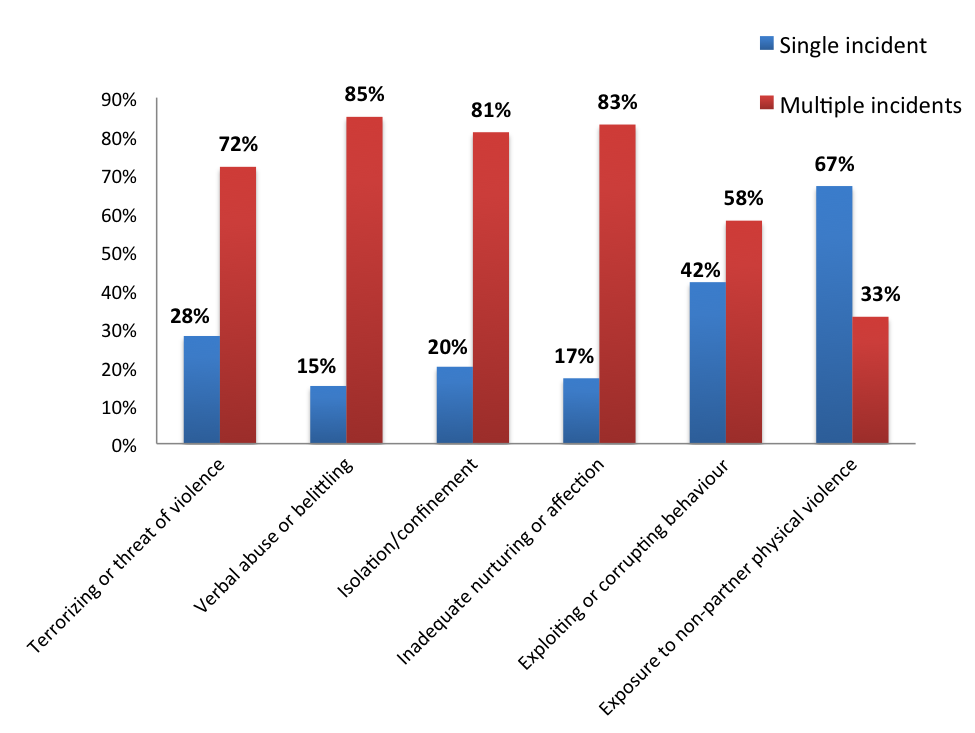Kozlowski, A., Lwin, K., & Fallon, B. (2014). A Profile of Reported Emotional Maltreatment in Canada in 2008. CWRP Information Sheet #134E. Montreal, QC: McGill University, Centre for Research on Children and Families.
Introduction
The Canadian Incidence Study of Reported Child Abuse and Neglect-2008 (CIS-2008) is the third nation-wide study to examine the incidence of reported child maltreatment and the characteristics of children and families investigated by child welfare authorities in Canada. In addition to the tables presented in the Major Findings Report[1], this information sheet examines descriptive findings about emotional maltreatment in Canada in 2008. The descriptive analyses presented in this information sheet were prepared by the authors with funding from a Social Sciences and Humanities Research Council Partnership Grant and a gift from the Royal Bank of Canada foundation to support the McGill Centre for Research on Children and Families’ Children’s Services Research and Training Program.
Findings
There were an estimated 235,842 maltreatment-related investigations conducted in Canada in 2008. An estimated 174,411 investigations were for an alleged incident of maltreatment and an estimated 61,431 were risk-only investigations. Emotional maltreatment was identified as the primary category of investigated maltreatment in 7% of maltreatment-related investigations (an estimated 15,627 investigations).
As shown in Figure 1, just under half (48%) of investigations in which emotional maltreatment was the primary category of investigated maltreatment were substantiated (an estimated 7,423 investigations), 19% were suspected (an estimated 2,973 investigations) and 34% were unfounded (an estimated 5,231 investigations).
Figure 1.
Level of substantiation for investigations in which emotional maltreatment was identified as the primary category of investigated maltreatment in Canada in 2008

Emotional maltreatment included six forms: terrorizing or threat of violence, verbal abuse or belittling, isolation or confinement, inadequate nurturing or affection, exploiting or corrupting behaviour, and exposure to non-partner physical violence. It should be noted that exposure to intimate partner violence (IPV) is tracked by the CIS as an altogether separate form of maltreatment, with an estimated 29,259 cases of primary substantiated exposure to IPV being documented by the CIS in 2008. Figure 2 outlines the specific forms of substantiated emotional maltreatment in Canada in 2008. Of the estimated 7,423 investigations in which emotional maltreatment was the primary category of substantiated maltreatment, verbal abuse and belittling accounted for 32%, exposure to non-partner physical violence (27%), followed by inadequate nurturing or affection (19%), terrorizing or threat of violence (16%), exploiting or corrupting behavior (5%) and isolation/confinement (1%).
Figure 2.
Forms of substantiated emotional maltreatment

The chronic nature of emotional maltreatment is highlighted in Figure 3 below. Other than situations involving exposure to non-partner physical violence, most cases of substantiated emotional maltreatment involve multiple incidents rather than single incidents.
Figure 3.
Single and multiple forms of substantiated emotional maltreatment

Evidence of mental or emotional harm was evident to the investigating worker in 36% of all investigations in which emotional maltreatment was the primary category of substantiated maltreatment (an estimated 2,668 investigations). In about two thirds (63%) of these investigations with documented emotional harm, the worker felt the child required therapeutic treatment to manage the symptoms of mental or emotional harm.
The three most noted child functioning concerns in investigations in which emotional maltreatment was the primary category of substantiated maltreatment were: (1) depression/anxiety/withdrawal (25% of investigations); (2) academic difficulties (25% of investigations), and (3) attachment issues (18% of investigations). Child welfare workers noted at least one child functioning concern in 52% of investigations in which emotional maltreatment was the primary category of substantiated maltreatment.
Summary
Emotional maltreatment was identified as the primary category of investigated maltreatment in 7% of maltreatment-related investigations (an estimated 15,627 investigations) and just under half of these investigations were substantiated (48% or an estimated 7,423 investigations). Of the six forms of emotional maltreatment, verbal abuse or belittling and exposure to non-partner physical violence accounted for the largest proportions of substantiated emotional maltreatment. Other than situations involving exposure to non-partner physical violence, most cases of substantiated emotional maltreatment involve multiple incidents rather than single incidents. Evidence of mental or emotional harm was evident to the investigating worker in just over one third of all investigations in which emotional maltreatment was the primary category of substantiated maltreatment and workers noted at least one child functioning concern in just over half (52%) of these investigations.
Background
Responsibility for protecting and supporting children at risk of abuse and neglect falls under the jurisdiction of the 13 Canadian provinces and territories and a system of Aboriginal child welfare agencies which have increasing responsibility for protecting and supporting Aboriginal children. Because of variations in the types of situations that each jurisdiction includes under its child welfare mandate as well as differences in the way service statistics are kept, it is difficult to obtain a nation-wide profile of the children and families receiving child welfare services. The Canadian Incidence Study of Reported Child Abuse and Neglect (CIS) is designed to provide such a profile by collecting information on a periodic basis from every jurisdiction using a standardized set of definitions. With core funding from the Public Health Agency of Canada and in-kind and financial support from a consortium of federal, provincial, territorial, Aboriginal and academic stakeholders, the CIS-2008 is the third nation-wide study of the incidence and characteristics of investigated child abuse and neglect across Canada.
Methodology
The CIS-2008 used a multi-stage sampling design to select a representative sample of 112 child welfare agencies in Canada and then to select a sample of cases within these agencies. Information was collected directly from child welfare workers on a representative sample of 15,980 child protection investigations conducted during a three-month sampling period in the fall of 2008. This sample was weighted to reflect provincial annual estimates.
For maltreatment investigations, information was collected regarding the primary form of maltreatment investigated as well as the level of substantiation for that maltreatment. Thirty-two forms of maltreatment were listed on the data collection instrument, and these were collapsed into five broad categories: physical abuse (e.g., hit with hand), sexual abuse (e.g., exploitation), neglect (e.g., educational neglect), emotional maltreatment (e.g., verbal abuse or belittling), and exposure to intimate partner violence (e.g., direct witness to physical violence). Workers listed the primary concern for the investigation, and could also list secondary and tertiary concerns.
For each form of maltreatment listed, workers assigned a level of substantiation. Maltreatment could be substantiated (i.e., the balance of evidence indicated that the maltreatment had occurred), suspected (i.e., the maltreatment could neither be confirmed nor ruled out), or unfounded (i.e., the balance of evidence indicated that the maltreatment had not occurred).
For each risk investigation, workers determined whether the child was at significant risk of future maltreatment. The worker could decide that the child was at significant risk of future maltreatment (confirmed risk), that the child was not at significant risk of future maltreatment (unfounded risk), or that the future risk of maltreatment was unknown.
A detailed presentation of the study methodology and of the definitions of each variable is available at http://cwrp.ca/publications/cis-2008-study-methods.
Limitations
The CIS collects information directly from child welfare workers at the point when they completed their initial investigation of a report of possible child abuse or neglect, or risk of future maltreatment. Therefore, the scope of the study is limited to the type of information available to them at that point. The CIS does not include information about unreported maltreatment nor about cases that were investigated only by the police. Also, reports that were made to child welfare authorities but were screened out (not opened for investigation) were not included. Similarly, reports on cases currently open at the time of case selection were not included. The study did not track longer-term service events that occurred beyond the initial investigation.
Three limitations to estimation method used to derive annual estimated should also be noted. The agency size correction uses child population as a proxy for agency size; this does not account for variations in per capita investigation rates across agencies in the same strata. The annualization weight corrects for seasonal fluctuation in the volume of investigations, but it does not correct for seasonal variations in types of investigations conducted. Finally, the annualization weight includes cases that were investigated more than once in the year as a result of the case being re-opened following a first investigation completed earlier in the same year. Accordingly, the weighted annual estimates represent the child maltreatment-related investigations, rather than investigated children.
Comparisons across CIS reports must be made with caution. The forms of maltreatment tracked by each cycle were modified to take into account changes in investigation mandates and practices. Comparisons across cycles must in particular take into consideration the fact that the CIS-2008 was the first to explicitly track risk-only investigations. In addition, readers are cautioned to avoid making direct comparisons with provincial and First Nations oversampling reports because of differences in the way national and oversampling estimates are derived.
[1] Trocmé, N., Fallon, B., MacLaurin, B., Sinha, V., Black, T., Fast, E., Felstiner, C., Hélie, S., Turcotte, D., Weightman, P., Douglas, J., & Holroyd, J. (2010) Canadian Incidence Study of Reported Child Abuse and Neglect – 2008: Major Findings, Chapters 1-5. Public Health Agency of Canada: Ottawa, 2010.
